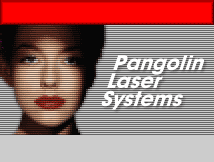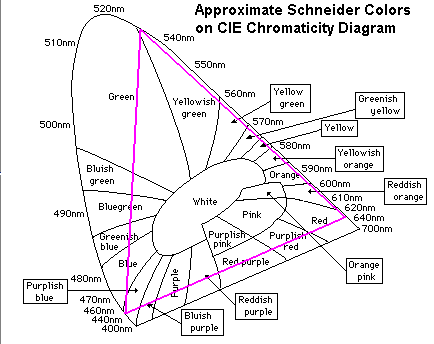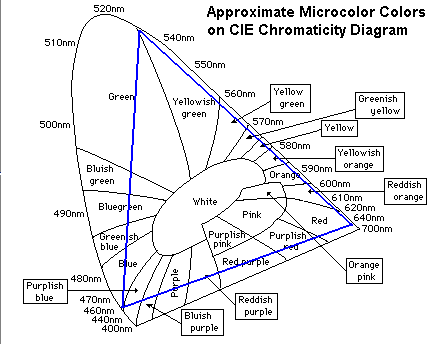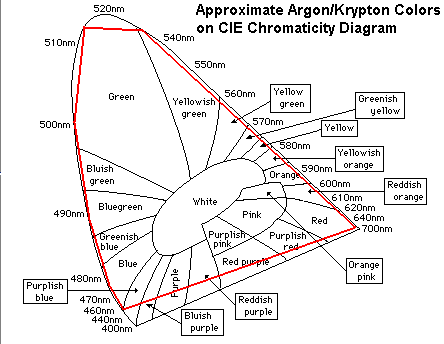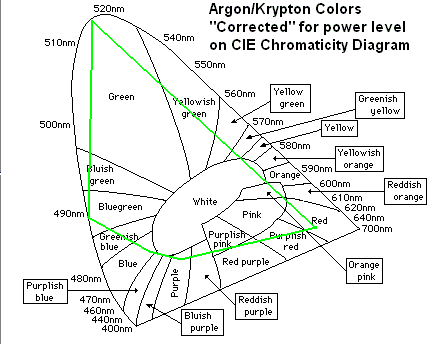|
|
More information about the new solid state lasers |
|
|
W |
hile making arrangements for the Pangolin Meetings and considering what type of laser to use, both AVI and Lighting Systems Designed offered the use of their new solid state, white-light lasers. We decided to accept the offer of both companies and it turned out to be an excellent choice for many reasons. Microcolor laser, made by LSDIThe first Pangolin Meeting was held in a meeting room at the Radisson Twin Towers. For this meeting, we used the Microcolor prototype laser from Lighting Systems Design. This laser delivered nearly 2 watts of white light, through two separate fibers. It was extremely convenient since the only utility needed was a 120V AC outlet. The laser is air cooled, but the fans are extremely quiet. Schneider Showlaser, provided by AVIThe second Pangolin Meeting was held at the offices of AVI. For this meeting, we used the Schneider Showlaser. As mentioned before, the Schneider Showlaser produces over 10 watts of white light through a single fiber. It runs off of a 220 volt AC outlet. Similarities between the two lasersThere are some similarities and differences between the lasers. As far as similarities, both lasers are completely self-contained and solid state. Both lasers consume very little power from essentially standard power outlets. Both lasers are relatively expensive and both lasers produce absolutely stunning colors. Differences between the two lasersAs far as the differences, some are pretty major and others are pretty subtle. The first major difference is the cost. The Schneider costs about as much as three large frame ion lasers, while the Microcolor is slated to cost around 1.5 times as much as a small frame ion laser. The second major difference is the weight. The Schneider weighs around 660 pounds while the Microcolor weighs only around 40 pounds. The Schneider laser is pulsed at 84MHz with 6ps pulses while the Microcolor is a continuous wave laser, just like an ion laser. The Schneider is a shipping product, while the Microcolor is still a prototype. Differences in blue wavelengthThere
is a subtle difference
in the colors produced
by each laser. Before getting into the specifics, let me make it
very clear that both lasers produce absolutely stunning colors. The
colors are so vibrant that they really do re-invigorate the
experience of watching laser shows. For many attendees, it was like
being bit by the laser bug all over again.
The blue wavelength of the Microcolor laser is 457nm. This is the same as the deep blue wavelength of an Argon laser. Although this is only 11nm from the blue wavelength of the Schneider laser, and although you still get very strong and saturated purples and deep blues, you dont have to mix nearly as much green with this wavelength to make a Royal Blue. As a result, the blue-green, cyan and light blue colors produced are slightly more saturated than the Schneider laser, but still not as saturated as theoretically possible with an Argon/Krypton laser.
Although the subtle difference does result in somewhat different colors produced by each laser, the viewing experience of both the Schneider and Microcolor lasers has a similar level of excitement. As I said, it is like being bit by the laser bug all over again. Why is the white "whiter" with solid-state lasers?In the center of the CIE Chromaticity Diagram, you will see the color white. Take note of the straight line between the Green and Blue wavelengths of the solid-state lasers. This line passes very close to white. Because of this, you really don't have to work very hard to make a nice white. Just add a little bit of red, and you're there. Differences between an Argon/Krypton laserAn Argon Krypton laser has at least six relatively strong wavelengths. If these wavelengths are modulated with LD2000's ability to control each wavelength separately, you can see that this might result in the most-saturated blue-green, cyan, and light blue colors. Taking a look at the CIE Chromaticity Diagram for an Argon/Krypton laser, you can see just where each wavelength lands and how saturated the colors are.
Why do the colors seem more saturated with solid-state lasers?If you look at the CIE Chromaticity Diagrams
above for all three lasers, it certainly looks like the
Argon/Krypton laser should have more saturated colors. But most
often, this does not appear to be the case. The reason has more to
do with power than wavelengths.
|
This page last updated: Tuesday, June 19, 2007 08:55 PM
